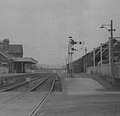Milk trains
The SR and later the Southern Region of British Railways ran two regular milk trains up from Torrington every day, which served both the United Dairies creamery and bottling plant at Vauxhall, and the Express Dairies creamery at Morden. Filled by road tankers from the Torridge Vale Dairies, the first train of eight wagons left Torrington at 14:47, the second of six at 16:37, split due to the weight of the full milk tank wagons. The first train arrived at Clapham Junction in the evening, and reduced its length by half so that it did not block Vauxhall station while unloading. It would then proceed to Vauxhall, and pull into the "down" side platform, where a discharge pipe was provided to the creamery on the other side of the road. There was also pedestrian access from below the station, under the road to the depot, in the tunnel where the pipeline ran. Unloaded train would then proceed to Waterloo, where it would reverse and return to Clapham Junction to pick up the other half of the train. The procedure was then repeated, so that the entire first milk train was unloaded between the end of evening peak traffic and the start of the following morning. The second train from Torrington would also split at Clapham Junction, but only half of its Milk Tanks would be hauled to Vauxhall, while the other half were dispatched to the Express Dairies depot at Morden. In the late morning, both trains now empty Milk Tanks would be combined into one express train, and returned to Torrington. Milk trains from Torrington stopped in 1978, the last milk train on the former SR. [5]





